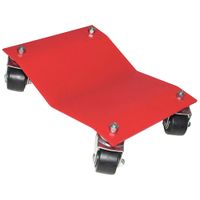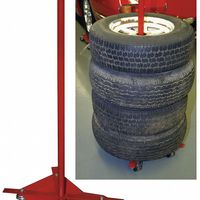Call +(254) 703 030 000 / 751 483 999 / 721 704 777
- Home
- Fleet Vehicle Maintenance
- Garage Equipment
- Garage Dollies
- Car Dollies Accessories
Car Dollies & Accessories
Car dollies slide under wheels to move vehicles without starting the engine. Car wheel dollies have casters that allow the vehicle to be moved in any direction. Each vehicle wheel is set on a dolly and the vehicle is rolled to a new location. Accessory parts for vehicle dollies include caster replac .....Read More
Frequently Asked Questions
What are car dollies used for?
Car dollies are tools used to move vehicles easily and safely, especially in tight spaces or for short distances. They are typically used in automotive repair shops, car showrooms, and by vehicle enthusiasts. Car dollies come in various designs, but generally, they consist of a platform with wheels or casters that support the vehicle's tires.
The primary use of car dollies is to facilitate the movement of vehicles without the need to start the engine. This is particularly useful for cars that are inoperable, undergoing repairs, or being stored. By placing a car on dollies, mechanics and car owners can maneuver the vehicle in any direction, making it easier to position it in a garage, workshop, or showroom.
Car dollies are also beneficial for maximizing space. In crowded garages or storage facilities, they allow vehicles to be parked closer together or moved into tight spots that would be difficult to access by driving. This is especially advantageous for car collectors or businesses with limited space.
Additionally, car dollies can be used for towing purposes. Some designs are specifically made to lift the front or rear wheels of a vehicle off the ground, allowing it to be towed by another vehicle. This is useful for transporting cars over short distances without causing wear and tear on the tires or drivetrain.
Overall, car dollies are versatile tools that enhance the efficiency and safety of vehicle handling, storage, and transportation.
How do car dollies work?
Car dollies work by providing a means to lift and transport a vehicle, typically for towing or moving purposes. They consist of a set of wheels and a platform or cradle that supports the vehicle's tires. Here's how they function:
1. **Positioning**: The car dolly is placed in front of or behind the vehicle, depending on whether the front or rear wheels need to be lifted. The vehicle is driven or pushed onto the dolly, aligning the tires with the dolly's cradles.
2. **Lifting**: Once the vehicle's tires are positioned on the dolly, a mechanism, often a hydraulic jack or a manual lever, is used to lift the vehicle's wheels off the ground. This elevates the vehicle, allowing the dolly to bear the weight.
3. **Securing**: The vehicle is secured to the dolly using straps or chains. These are fastened around the tires or the vehicle's frame to prevent movement during transport. Proper securing is crucial to ensure safety and stability.
4. **Towing or Moving**: With the vehicle's wheels lifted and secured, the dolly can be attached to a tow vehicle, such as a truck or another car. The dolly's wheels allow for smooth movement, enabling the vehicle to be towed without its own wheels touching the ground.
5. **Steering and Maneuvering**: Some car dollies have swivel wheels or a pivoting mechanism that allows for easier steering and maneuvering, especially around tight corners or in confined spaces.
Car dollies are particularly useful for front-wheel-drive vehicles, as they lift the drive wheels off the ground, preventing transmission damage during towing. They are also used in garages or workshops to move vehicles without starting the engine.
Can car dollies damage my vehicle?
Car dollies, when used correctly, generally do not damage vehicles. They are designed to lift and transport vehicles safely, often used for towing or moving cars in tight spaces. However, improper use or poor-quality dollies can lead to potential damage.
1. **Weight Capacity**: Ensure the dollies are rated for your vehicle's weight. Overloading can cause structural failure, leading to damage.
2. **Proper Placement**: Incorrect placement of dollies can stress suspension components or undercarriage parts. Always follow the manufacturer's guidelines for placement.
3. **Securing the Vehicle**: Failing to secure the vehicle properly on the dollies can result in shifting or falling, causing damage. Use straps or chains as recommended.
4. **Surface Conditions**: Using dollies on uneven or rough surfaces can lead to instability, increasing the risk of damage. Ensure the surface is smooth and level.
5. **Quality of Dollies**: Low-quality or damaged dollies may not function correctly, leading to potential vehicle damage. Invest in high-quality, well-maintained equipment.
6. **Tire and Wheel Concerns**: If the vehicle is left on dollies for extended periods, it can cause flat spots on tires or stress on wheel bearings. Regularly check and adjust the vehicle's position.
7. **Towing Considerations**: When towing with dollies, ensure the vehicle is properly aligned and secured to prevent swaying or detachment, which can cause damage.
In summary, while car dollies are generally safe, attention to weight limits, proper placement, securing methods, and equipment quality is crucial to prevent vehicle damage.
What weight capacity do I need for car dollies?
To determine the weight capacity needed for car dollies, consider the following factors:
1. **Vehicle Weight**: Know the total weight of your vehicle. This information can typically be found in the owner's manual or on the manufacturer's website.
2. **Dolly Configuration**: Decide if you will use two or four dollies. Using four dollies distributes the weight more evenly, while two dollies will need to support more weight each.
3. **Weight Distribution**: Consider the weight distribution of your vehicle. Front-heavy vehicles, like those with large engines, may require higher capacity dollies at the front.
4. **Safety Margin**: Add a safety margin to the weight capacity. A 20% buffer is generally recommended to ensure the dollies can handle unexpected loads or uneven weight distribution.
5. **Individual Dolly Capacity**: Divide the total vehicle weight by the number of dollies you plan to use. For example, if your vehicle weighs 4,000 pounds and you are using four dollies, each dolly should support at least 1,000 pounds. With a 20% safety margin, each dolly should have a capacity of at least 1,200 pounds.
6. **Dolly Specifications**: Check the specifications of the dollies you are considering. Ensure they meet or exceed the calculated capacity per dolly.
By considering these factors, you can select car dollies with the appropriate weight capacity to safely support and maneuver your vehicle.
Are car dollies easy to use?
Car dollies are generally easy to use, but their ease of use can depend on several factors, including the type of dolly, the user's experience, and the specific task at hand.
There are two main types of car dollies: tow dollies and wheel dollies. Tow dollies are used for transporting vehicles by lifting the front wheels off the ground, while wheel dollies are used for moving vehicles short distances in garages or workshops.
For tow dollies, ease of use involves properly securing the vehicle to the dolly, which requires some knowledge of the vehicle's weight distribution and the dolly's capacity. Users must ensure that the vehicle is correctly aligned and securely fastened to prevent accidents during transport. This process can be straightforward with practice, but beginners may find it challenging initially.
Wheel dollies, on the other hand, are typically easier to use. They involve placing each dolly under a wheel and then using them to maneuver the vehicle. This is particularly useful in tight spaces where driving the vehicle is not feasible. Wheel dollies often come with casters that allow for 360-degree movement, making it easy to reposition the vehicle. However, users must ensure that the dollies are rated for the vehicle's weight and that the surface is smooth and level to prevent tipping.
In both cases, safety precautions are essential. Users should wear appropriate safety gear and follow the manufacturer's instructions. Overall, with the right equipment and a bit of practice, car dollies can be a convenient and efficient tool for moving vehicles.
How do I choose the right car dollies?
1. **Weight Capacity**: Ensure the dollies can support the weight of your vehicle. Check the manufacturer's specifications for maximum load capacity.
2. **Wheel Size and Type**: Larger wheels offer better maneuverability, especially on uneven surfaces. Consider the material (e.g., rubber, polyurethane) for durability and surface protection.
3. **Material and Construction**: Look for sturdy materials like steel or heavy-duty aluminum. Ensure the construction is robust to withstand regular use.
4. **Adjustability**: Some dollies offer adjustable widths to accommodate different tire sizes. This feature is useful if you plan to use them for multiple vehicles.
5. **Braking System**: A reliable braking system is essential for safety, especially on inclined surfaces. Check for easy-to-use and effective brakes.
6. **Ease of Use**: Consider how easy it is to position and secure the car on the dollies. Features like swivel casters can enhance maneuverability.
7. **Storage and Portability**: If space is a concern, look for foldable or stackable dollies. Lightweight options are easier to transport and store.
8. **Surface Compatibility**: Ensure the dollies are suitable for the surfaces you’ll be using them on, such as concrete, asphalt, or gravel.
9. **Price and Warranty**: Compare prices and check for warranties or guarantees. A higher price may reflect better quality or additional features.
10. **Reviews and Recommendations**: Read customer reviews and seek recommendations from automotive professionals to gauge reliability and performance.
11. **Brand Reputation**: Consider reputable brands known for quality and durability in automotive tools and accessories.
12. **Intended Use**: Determine if you need dollies for short-term use, long-term storage, or frequent vehicle movement, and choose accordingly.
Where can I buy car dollies and accessories?
You can buy car dollies and accessories from a variety of sources:
1. **Automotive Retailers**: Stores like AutoZone, Advance Auto Parts, and O'Reilly Auto Parts often carry car dollies and related accessories. They may offer both in-store and online shopping options.
2. **Online Marketplaces**: Websites such as Amazon, eBay, and Walmart.com provide a wide selection of car dollies and accessories. These platforms often feature customer reviews, which can help in making informed purchasing decisions.
3. **Specialty Tool Stores**: Retailers like Harbor Freight Tools and Northern Tool + Equipment specialize in tools and equipment, including car dollies. They offer both physical locations and online shopping.
4. **Home Improvement Stores**: Chains like Home Depot and Lowe's sometimes stock automotive tools and accessories, including car dollies, especially in larger locations or online.
5. **Automotive Supply Websites**: Websites like Summit Racing, JEGS, and Eastwood cater specifically to automotive enthusiasts and professionals, offering a range of car dollies and accessories.
6. **Local Dealerships and Repair Shops**: Some car dealerships and repair shops may sell or order car dollies and accessories for you, especially if they have a parts department.
7. **Classifieds and Second-Hand Options**: Platforms like Craigslist, Facebook Marketplace, and OfferUp can be good places to find used car dollies at a lower price.
8. **Direct from Manufacturers**: Some manufacturers sell directly to consumers through their websites, offering a range of products and sometimes exclusive deals.
9. **Automotive Shows and Swap Meets**: These events can be a good place to find both new and used car dollies and accessories, often at discounted prices.
Consider factors like price, shipping options, and return policies when choosing where to buy.

